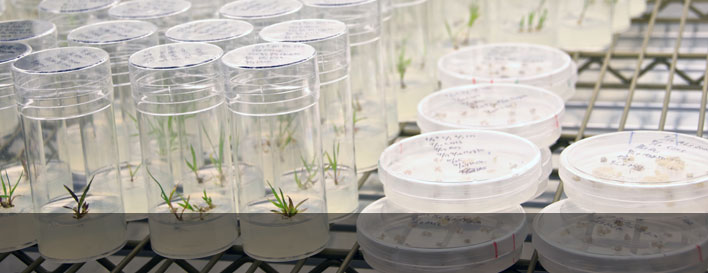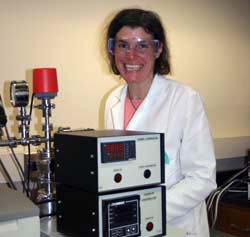Dr. Friederike Jentoft


Catalysis Research for Improved Biofuels Production
 Dr. Jentoft's research focus is catalyst reaction and characterization. Catalysis enables the efficient industrial production of chemicals and fuels. The challenge is to understand how catalytic reactions proceed and to develop novel catalysts. Acid–base catalysis is a core area of her research.
Dr. Jentoft's research focus is catalyst reaction and characterization. Catalysis enables the efficient industrial production of chemicals and fuels. The challenge is to understand how catalytic reactions proceed and to develop novel catalysts. Acid–base catalysis is a core area of her research.
Solid acid catalysts are important in tailoring the size and structure of hydrocarbons for their use as fuels. An emerging application of acid and base catalysts is the conversion of biomass compounds. Smart chemistry and innovative reaction engineering are required to alter or remove the high number of functionalities in such molecules. Additional target reactions in the research program are selective hydrogenation and oxidation.
Dr. Jentoft's research goal is to improve activity, selectivity, and stability of catalysts on the basis of profound understanding of the catalytic process. Key competences are in the areas of catalyst preparation, testing and spectroscopic characterization. She and her co-researchers are able to tune the chemical and morphological properties of oxide catalysts through promotion–that is, by adding the right amount of the right ingredient–and through optimized thermal treatment. These skills are applied in the preparation of solid acids and bases, and oxide-supported metal nanoparticles.
One of the primary techniques used for the investigation of catalysts is infrared (IR) spectroscopy, which delivers information on surface structures through their vibrational signature. Dr. Jentoft and her colleagues have developed an apparatus for quantitative measurements that enables them to determine extinction coefficients. This allows the researchers to track how individual chemical bonds are activated through interaction with the catalyst surface.
Ultraviolet–visible (UV–vis) spectroscopy is widely used to investigate valence and dispersion of catalyst components. Dr. Jentoft's expertise includes the analysis of surface deposits that are responsible for catalyst deactivation, and the characterization of small metal particles by their surface plasmon resonance.
Diffuse reflectance spectroscopy is a technology that is ideally suited for the investigation of high surface area powders by UV–vis and IR spectroscopy. Spectra can be recorded over wide temperature and pressure ranges. Typical reaction conditions can thus be established inside the spectroscopic cell, and catalysts can be watched at work.
Research Articles
- Jentoft, R. E., A. P. Hahn, F. C. Jentoft, and T. Ressler (2005). "In Situ XANES Study of Mn in Promoted Sulfated Zirconia Catalysts." Physical Chemistry Chemical Physics 7.14: 2830-838. Physical Chemistry Chemical Physics. doi: 10.1039/B505464H.
Access the publication
- Muller, J. O., D. S. Su, R. E. Jentoft, J. Krohnert, F. C. Jentoft, and R. Schlogl (2005). "Morphology-controlled Reactivity of Carbonaceous Materials towards Oxidation." Catalysis Today 102-103: 259-65. SciVerse. doi: 10.1016/j.cattod.2005.02.025.
Access the publication
- Jentoft, F. C., A. Hahn, J. Kröhnert, G. Lorenz, R. E. Jentoft, T. Ressler, U. Wild, R. Schlögl, C. Häßner, and K. Köhler (2004). "Incorporation of Manganese and Iron into the Zirconia Lattice in Promoted Sulfated Zirconia Catalysts." Journal of Catalysis 224.1: 124-37. SciVerse. doi: 10.1016/j.jcat.2004.02.012.
Access the publication
- Yang, X., F. C. Jentoft, R. E. Jentoft, F. Girgsdies, and T. Ressler (2002). "Sulfated Zirconia with Ordered Mesopores as an Active Catalyst for N-Butane Isomerization,." Catalysis Letters 81: 25-31. Springer Link. doi: 10.1023/A:1016095603350.
Access the publication
- Hahn, A., T. Ressler, R. E. Jentoft, and F. C. Jentoft (2001). "The Role of the "Glow Phenomenon" in the Preparation of Sulfated Zirconia Catalysts." Chemical Communications: 537-38. RSC Publishing. doi: 10.1039/B100364J.
Access the publication
Reviews and Feature Articles
- Jentoft, F. C. (2009). "UV–vis–NIR Spectroscopy in Catalysis: Theory, Experiment, Analysis, and Application under Reactive Conditions." Review. Advances in Catalysis, 52: 129-11.
- Bron, M., D. Teschner, A. Knop-Gericke, F. C. Jentoft, J. Kröhnert, J. Hohmeyer, C. Volckmar, B. Steinhauer, R. Schlögl, and P. Claus (2007). "Silver as Acrolein Hydrogenation Catalyst: Intricate Effects of Catalyst Nature and Reactant Partial Pressures." Physical Chemistry Chemical Physics 9.27: 3559-569. RSC Publishing. doi: 10.1039/B701011G.
Access the publication
- Jentoft, F. C., and B. C. Gates (1997). "ChemInform Abstract: Solid-Acid-Catalyzed Alkane Cracking Mechanisms: Evidence from Reactions of Small Probe Molecules." Topics in Catalysis 4.1-2: 1-13. Springer Link. doi: 10.1023/A:1019184004885.
Access the publication
Book Contributions
- Jentoft, F. C., H. Knözinger, F. Schüth, and J. Weitkamp (2008). "Oxo-Anion Modified Oxides." Handbook of Heterogeneous Catalysis. Ed. G. Ertl. 2nd ed. Vol. 1. Wiley-VCH. 262-78. Wiley Online Library. doi: 10.1002/9783527610044.hetcat0014.
Access the publication
Rational Approach Towards Novel Catalysts for Biomass Conversion and Upgrading by Friederike Jentoft
A presentation in the OK EPSCoR Biofuels Teleconference Series
